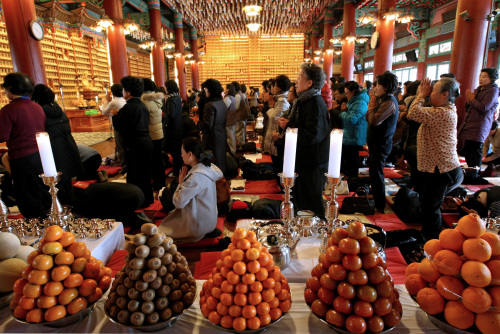The worst outbreak of foot-and-mouth disease in Asia for at least 50 years may get more severe as Lunar New Year holidays spark a surge in travel, threatening to spread the virus that has decimated South Korea’s livestock.
The magnitude of the outbreak is “unlike anything that we’ve seen for at least half a century,” Juan Lubroth, chief veterinary officer at the United Nations’ Food and Agricultural Organization in Rome, said Thursday in a statement. Asia is a “cause of concern” because during next week’s holiday “large numbers of people will be on the move in the region, many of them carrying meat products and some transporting animals.”
China’s government forecast that its citizens would make 2.85 billion journeys during the 40-day period that started Jan. 19. South Korea will kill 20 percent of its herd to halt the spread of the highly infectious livestock disease, in an operation that the FAO said had already cost about $1.6 billion.
The magnitude of the outbreak is “unlike anything that we’ve seen for at least half a century,” Juan Lubroth, chief veterinary officer at the United Nations’ Food and Agricultural Organization in Rome, said Thursday in a statement. Asia is a “cause of concern” because during next week’s holiday “large numbers of people will be on the move in the region, many of them carrying meat products and some transporting animals.”
China’s government forecast that its citizens would make 2.85 billion journeys during the 40-day period that started Jan. 19. South Korea will kill 20 percent of its herd to halt the spread of the highly infectious livestock disease, in an operation that the FAO said had already cost about $1.6 billion.

The outbreak, the fifth in South Korea since 2000, will lead to the slaughter of 2.7 million animals, mostly pigs and cattle. The nation’s biggest cull may frustrate President Lee Myung-bak’s vow to limit inflation to less than 3 percent as meat shortages add to record global food costs. Wholesale pork prices in South Korea soared 88 percent as of Jan. 25 from a month earlier, while beef may jump 14 percent this month from the 2005-2009 average, according to the agricultural ministry.
“High food prices impact on inflation but also on poverty and hunger, which can lead to social and political unrest,” Indonesia’s President Susilo Bambang Yudhoyono said at the World Economic Forum in Davos.
Risks of global instability are rising as governments cut subsidies that help the poor cope with surging food costs to ease budget crunches, the head of the United Nations’ World Food Program said this week.
“We’re in an era where the world and nations ignore the food issue at their peril,” Josette Sheeran said in a Jan. 24 interview at the agency’s Rome headquarters.
The U.N.’s Food Price Index surged to 214.8 in December, exceeding the previous record in 2008 when rising costs and fears of shortages sparked riots from Haiti to Egypt. More than 100 people have died this month in protests in Tunisia against food inflation, unemployment and alleged corruption, according to the U.N., and at least three were killed in Algeria. Tunisian leader Zine El Abidine Ben Ali fled into exile Jan. 14.
More than 60 food riots occurred worldwide from 2007-2009, according to the U.S. State Department. At that time, soaring prices and fears of shortages led exporters such as Indonesia to restrict or tax exports of rice and other foods.
Foot-and-mouth has, in recent years, made an “unparalleled spread through China and entered eastern regions of Russia and Mongolia for the first time,” according to the statement. The disease recently affected an estimated 1.5 million Mongolian gazelles, which may have helped carry the virus into China during their migration, it said.
Foot-and-mouth affects cattle, sheep, pigs and other cloven hoofed animals. While it isn’t dangerous to people, it can devastate farms.
“Affected animals become too weak to be used to plough the soil or reap harvests, and farmers cannot sell the milk they produce due to infection by the virus,” the FAO statement said.
(Bloomberg)







![[Graphic News] More Koreans say they plan long-distance trips this year](http://res.heraldm.com/phpwas/restmb_idxmake.php?idx=644&simg=/content/image/2024/04/17/20240417050828_0.gif&u=)
![[KH Explains] Hyundai's full hybrid edge to pay off amid slow transition to pure EVs](http://res.heraldm.com/phpwas/restmb_idxmake.php?idx=644&simg=/content/image/2024/04/18/20240418050645_0.jpg&u=20240419100350)





![[From the Scene] Monks, Buddhists hail return of remains of Buddhas](http://res.heraldm.com/phpwas/restmb_idxmake.php?idx=652&simg=/content/image/2024/04/19/20240419050617_0.jpg&u=20240419175937)

![[KH Explains] Hyundai's full hybrid edge to pay off amid slow transition to pure EVs](http://res.heraldm.com/phpwas/restmb_idxmake.php?idx=652&simg=/content/image/2024/04/18/20240418050645_0.jpg&u=20240419100350)

![[Today’s K-pop] Illit drops debut single remix](http://res.heraldm.com/phpwas/restmb_idxmake.php?idx=642&simg=/content/image/2024/04/19/20240419050612_0.jpg&u=)